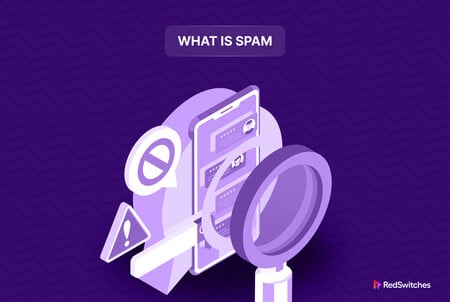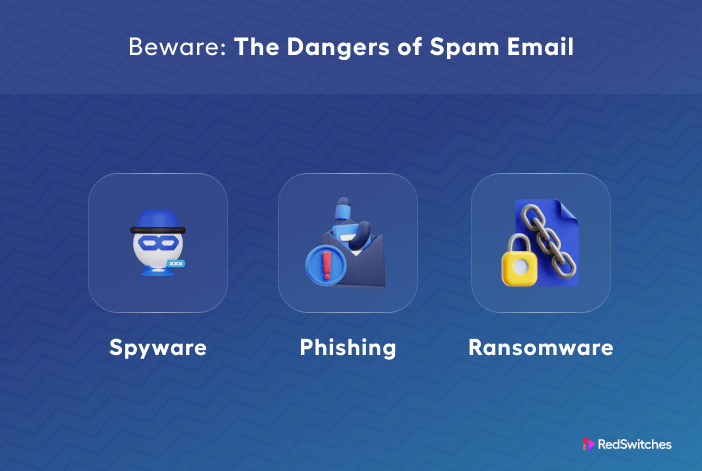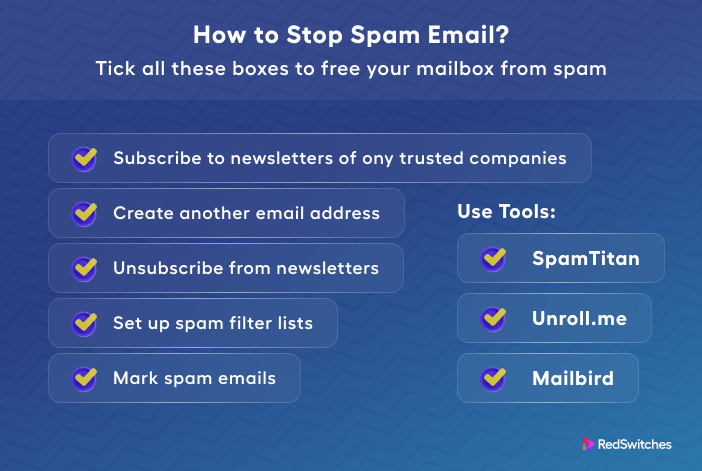Do you know that the first spam email was sent in May 1978?
That’s right!
Spam emails have been a persistent annoyance for more than 40 years.
These unwanted, frequently pointless emails clog up our inboxes and are often used to launch attacks against businesses.
In this article, we’ll examine the widespread problem of spam emails and offer tips for successfully fending them off. Join us as we investigate solutions to the decades-old question: how to stop spam emails?
Let’s start with the introductions.
Table Of Contents
- What is Spam Email?
- Dangers of Spam Email
- How To Stop Spam Emails
- How to Block Unwanted Emails
- Conclusion
- FAQs
What is Spam Email?
Email spam, commonly called junk email, sends unrequested emails to a massive list of subscribers en masse. All spam emails these days are sent by a custom-built botnet, a collection of malware-infected machines under the control of an attacker (the “bot herder”).
The term “spam” is borrowed from a Monty Python skit in which the character complains that the canned product’s name is overused, annoying, and repetitious.
Spam email is not a harmless annoyance. To give you an idea of the scale of the problem, consider this: 56% of all emails sent in 2022 were spam emails. Of this, 73% of spam emails were used to initiate phishing and identity theft attacks on the recipients.
The problem has spread to include text messages and social media platforms that are used to duplicate the contents of spam emails on these channels.
Common Characteristics of Spam
Before jumping to our main question: How to stop spam emails? In this section, we will discuss the features/characteristics of Spam emails.
Be Wary of Business Emails From Common Email Platforms or Fishy Domains
While the sender name and the design of spam emails resemble a brand’s official design and color scheme, the email address is often located on common email platforms such as Yahoo, Yandex, or Gmail.
Similarly, the emails could originate from fishy domains used exclusively for hosting botnets and spam email addresses. These domains often combine numbers and alphabets in the name (a common red flag).
Beware of Sloppy Grammar
Businesses invest significant efforts in crafting their email messages. These efforts include paying special attention to the language and message delivery techniques used in the email body.
So, if you receive an email from an established brand and spot spelling and grammar mistakes, you should immediately mark the email as spam.
Missing or Ambiguous Email Signature
Like the language, businesses pay attention to the sender’s email signature. This email component is specially formatted to include critical information about the sender and their organization. At the very least, business email signatures have the sender’s name, designation, department, and email address. In addition, businesses include website addresses and social media links to ensure the recipients can get more information about the business and the sender.
So, if the email has no signature or just a name or a vague designation, steer clear and mark it as spam.
Dangers of Spam Email
Before moving to our core question of how to stop spam emails, you should understand the dangers posed by spam emails.
Spyware in Spam Emails
Hackers can easily conceal malicious spyware software in spam emails. The spyware can covertly track your computer actions, including tracking your emails, usernames, and passwords when you inadvertently open these emails. The hacker needs just a click on a malicious link in the spam email to access your critical information, including online banking details. You’ll likely never even be aware that your computer has been compromised.
Phishing in Spam Emails
A typical phishing attack involves a malicious attempt to get your personal information. Scammers mimic credible brands and sources and directly ask for your private information through fake web pages.
You should be very careful about emails received from brands and sources, especially if you don’t use their services. Even if you have an account, it is always a good practice to ignore the link in the email, go to the official website, and carry out the requested action.
Impact on Personal and Professional Life
Both personal and professional lives can be dramatically disrupted by spam emails.
These emails clog up inboxes, making it difficult to identify relevant messages. The problem becomes acute when you miss crucial emails from vendors and relatives. Spam emails can quickly consume the storage space allocated to business email accounts. All this results in missed deadlines and opportunities.
Falling victim to phishing scams delivered by spam emails can cause significant financial losses and unintentional release of sensitive business data. Spam emails constitute a complex threat that can ruin personal and professional relationships.
How To Stop Spam Emails
Now that you know the dangers of spam emails, let’s get to the core of this article and answer the question on your mind: how to stop spam emails
We’ll discuss three ways to stop getting spam emails in your inboxes.
Activate Email Filtering and Spam Folders
Your email platform and client employ email filtering, a process that checks all incoming emails for known spam email red flags. Once identified, the emails are automatically transferred to a separate isolated spam folder.
Spam filters evaluate an incoming email using various known criteria. They search for typical trigger words like “free” and “earn money” that indicate an unsolicited email trying to scam you with a substandard product or service.
Spam filters also mark all emails addressed to your email handle rather than your name. This indicates that the sender doesn’t know you or is not in your contact list. Similarly, all emails originating from senders that attempt to subscribe your email address to newsletters without your permission are marked as spam.
Unsubscribe Wisely
Instead of pressing the “unsubscribe” button at the bottom of an email, go to the company’s website to remove your name from their mailing list. This step is critical because many spam emails include fake and bogus “unsubscribe” links that don’t work or, worse, redirect to harmful web pages.
While there, report the email as spam and delete it without opening it. Any communication with the spammer will reveal to them that you are a potential customer with a functioning email account.
Avoid Publicizing Your Email Address
To prevent spam and avoid making your email address public:
- Use Disposable Addresses: Use temporary email addresses when interacting and signing up for non-critical online services.
- Divide Up Your Email: Keep three email addresses – one for work, one for personal correspondence, and one for the rest of your emails.
- Share as little information as possible while completing online forms.
- Email providers use the built-in spam filters to identify and remove spam emails.
- Be cautious on social media and refrain from including your email in posts or public profiles.
How to Block Unwanted Emails
After discussing how to stop getting spam emails, it is time to discuss ways to block unwanted emails. While not essentially spam, these emails are a hassle and pose a security challenge.
Using Block and Report Features
The Block option that all email platforms provide is very useful in separating unwanted emails from important ones.
When an email is blocked, it is automatically sent to the Spam folder. However, in some cases, it’s not marked as spam. So, if you think an email is spam, you should explicitly report it as such.
Implement Third-Party Anti-Spam Solutions
We recommend setting up and customizing third-party spam filtering solutions like Sanebox and SpamTitan.
Once activated, you should invest time in properly setting up and configuring these solutions so that they can better identify and block spam emails from hitting your inbox. Additionally, you can build whitelists and blacklists, modify filter sensitivity settings, and even design custom rules. These solutions integrate with your current email provider and are flexible enough to work with your email processes.
Secure Your Email Account
Securing your business email addresses is an essential aspect of how to block spam emails.
Let’s have a look at some tips for securing critical email addresses.
Use a Secure Password
A strong password is the first step in blocking spam email.
A good password is too complex to guess and follows the best practices for creating strong passwords. We recommend that your email inbox password be 12 characters long and combine uppercase, lowercase, digits, and symbols.
Activate Two-Step Verification
In addition to strong passwords, you should enable two-step verification to add another security layer to your inbox.
When two-step verification is enabled, logging in from an unfamiliar source (a computer in a different location than you regularly log in from) will require you to input a unique security code that is delivered to you through SMS or in an authentication app.
Because of this, even if someone were to guess your email password, they would still need access to your phone to sign in.
Conclusion
In this blog, we answered the basic question of how to stop spam emails.
Fighting the threat of spam emails is crucial for maintaining a clutter-free mailbox and ensuring your online safety. Spam emails are a serious threat to business operations because they can be used to initiate phishing attacks on your business.
You may regain control of your mailbox and have a safer, more productive online experience by practicing the strategies we outlined above. We also recommend working with a security-focused hosting provider such as RedSwitches. We take security very seriously and help businesses set up a secure infrastructure. Get in touch with our teams to understand how we can help you set up a secure environment for your operations.
FAQs
Q: What are a few typical traits of spam emails?
Generic salutations, dubious sender addresses, misspelled words, guarantees of rapid fortune, and requests for personal information are typical spam email traits.
Q: How do you stop Spam emails?
Use temporary email addresses when necessary, and stay away from posting your email address on open forums or websites.



